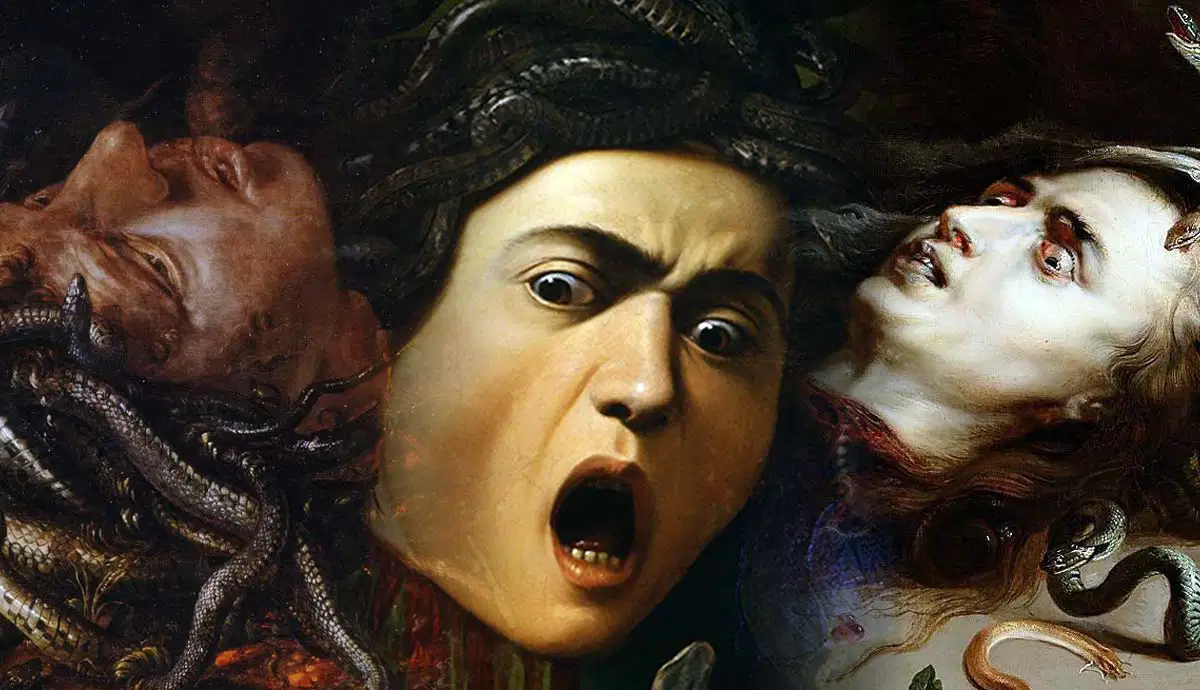
A monster, a warning against the evils of lust, and a shield of protection – these are just some of the faces of the woman whose gaze turned men to stone. Medusa is a figure who has long haunted the imaginations of writers and artists across centuries. Today, her story is at the heart of feminist discourse, where her petrifying face became a symbol of female empowerment and rage.
Who Was Medusa?

Medusa was a gorgon whose eyes had the power to turn men to stone. The gorgon and her two sisters, Stheno and Euryale, were the offspring of the primordial sea goddess Ceto and her brother Phorcys. While all three sisters had hair made of living snakes and a petrifying gaze, Medusa was the only mortal among them. She was beheaded in her sleep by Perseus, the son of Zeus and Danaë, with the help of Athena, Hermes, and Hades. According to Hesiod’s Theogony, “when Perseus cut off her head, there sprang forth great Chrysaor and the horse Pegasus” – her two children from Poseidon, the God of the sea.
Perseus later used her decapitated head, which retained its ability to turn people to stone, as a weapon against his enemies. Eventually, he offered it to Athena to place it on her shield. Henceforth, Medusa’s head became a symbol and device for warding off evil.
Was Medusa A Monster or A Victim?

Medusa was both a monster and a victim. Earlier narratives of the myth depicted Medusa as a monstrous creature. She represented an obstacle to be conquered and overcome along the hero’s journey. Such was not only the case in the myth of Perseus’s legendary quest, but also in Dante’s reimagination of Medusa in The Divine Comedy. She was typically depicted in art as a gruesome creature, terrorizing onlookers with her petrifying gaze and serpent hair. Depiction of Gorgonian beauty in art was also within the context of terror.
Her beauty was considered a menacing deception that had to be averted. Medusa’s image only started to change after Ovid’s Metamorphosis, where he introduced her origin story. As C. Luke Soucy noted, “In no tradition prior to the Metamorphoses had Medusa ever been anything but a monster” (Soucy, 2023).

In his epic poem, Ovid portrayed Medusa as a beautiful woman whose “best of all features was her hair” (Ovid, 8AD). She served at the shrine of Minerva, the Roman equivalent of Athena, the Ancient Greek goddess of wisdom and war. Ovid’s version of Medusa’s myth reinterpreted her intercourse with Neptune (Poseidon) as a tragic incident of rape: “The sea lord raped her in Minerva’s shrine” (Ovid, 8AD).
In response to the desecration of her shrine, Minerva punished Medusa by turning her beautiful hair into gruesome snakes and transforming her into a monster. Ovid’s origin story portrayed Medusa as a victim of outrageous divine injustice. Medusa was raped in Minerva’s shrine by a God, and rather than intervening to stop Neptune’s horrendous crime, the goddess of wisdom punished her for it and eventually helped Perseus kill her. Sexual violence, victim-blaming, and divine injustice are all themes that predominate Ovid’s Metamorphosis.
How Did Feminist Writers Reinterpret Medusa?

Feminist writers reinterpreted Medusa as a symbol of female rage, victimhood, and resilience against patriarchal power. Trapped in the ink of phallocentric authors, Medusa was never the protagonist of her own story. Her myth has long been read as a legendary tale of Perseus’s heroic triumph over the monstrous creature who did not even instigate his animosity. Despite Ovid’s account, Medusa’s victimhood has been consistently dismissed and overshadowed by Perseus’s celebrated murder. By the 19th century, feminist authors took back the pen from their misogynist predecessors, reclaiming Medusa’s tale with justice.

One of the first appearances of Medusa in feminist discourse was in Héléne Cixoux’s The Laugh of The Medusa. Originally published in 1975, the essay discussed Medusa’s portrayal as a monstrous figure in the context of men’s fear of female power and sexuality. By presenting Medusa as a beautiful and laughing woman, Cixoux aimed at unarming patriarchy from one of its most powerful weapons: demonizing female power, authority, and sexuality.
With the rise of feminist authors reclaiming Medusa, the myth of the petrifying monster soon became a symbol of female power and rage. During the interviews Professor Mary Valentis conducted for her book, Female Rage, she reported that whenever women were asked “what female rage looked like to them, it was always Medusa, the snaky-haired monster of myth, who came to mind” (Velantis, 1994).
Relevance Today

Medusa, however, was more than just a representation of female power. As a victim of sexual violence and victim-blaming, Medusa’s story resonates ever more deeply with women today. Her face became a testimony against the great injustice sexual assault victims suffer every day. During the me-too movement, artist Judy Takács named her painting #Me(dusa)too. Throughout social media platforms, Medusa quickly became the face of a movement against misogynistic sexual and social injustice.
Women worldwide started tattooing Medusa’s head as a symbol of survival from sexual violence and resilience against injustice. The feminist reinterpretation of Medusa transformed the once male-centric myth into a source of female empowerment and inspiration.
Perseus may have defeated Medusa in an ancient tale, but today Medusa triumphs through the women who reclaimed the power of her gaze.








